
IPO is an organization of international accompaniment and communication working in solidarity with organizations that practice nonviolent resistance.
Where we work:
Artículos relacionados
22.09.10: Harassment of IPO members and Fact-Finding Mission in El Tarra
3.06.10: Promotion and defense of human rights in the Rural workers reserve zone in the Cimitarra Valley
19.04.10: Humanitarian Refugee Camp Documentary
24.03.10: Grassroots Initiatives Challenge Water Privatization
12.03.10: Second Ecological Camp: Between fear and hope
17.02.10: Government officials withdraw from Negotiations with ASCAMCAT
12.02.10: IPO declares its solidarity against arrests in Catatumbo
8.10.09: New Farmers Organization Creates Alternatives to Forced Displacement
16.06.09: "We are tired of death": Letter to the special rapporteur on extrajudicial executions by the UN
6.06.09: A child dies, far from medical assistance
otros...
15.04.12: Gallery of Remembrance Assaulted, Censored, and Threatened on April 9 in Villavicencio, Meta
18.02.12: Civilian dwellings in Agualinda bombed by the Army’s 4th Division
19.12.11: More Human Rights Violations in Huila
26.11.11: ASOCBAC Leader Fredy Jimenez Assassinated in Taraza
12.11.11: Member of CPDH held captive for 40 days
Topic Tree:
Ambiente
Alternative Comunication
Economia
Sindicatos
Comunidades indígenas
Coca
Comunidades campesinas
International Politic
Politica nacional
Justicia
Kidnapping
Parapolitica
Narcotrafico
Acuerdo Humanitario
Impunity
Ley de Justicia y Paz
Multinacionales y recursos naturales
Politica nacional
Acuerdo Humanitario
Narcotrafico
Parapolitica
Kidnapping
Armed Conflict
Paramilitarismo
FARC-EP
ELN
Plan Colombia
Vioations Human Rights
Positive Faults
Desplazamiento
Asesinados Políticos
Torture
Political Prisoners
Regions
Chocó
Tolima
Catatumbo
Meta
Periferias
Arauca
Magdalena Medio
Nord Est Antioquia
Sur de Bolivar
License

This work is licensed under
Creative Commons
PayPal
Humanitarian Refugee Camp Declared in Catatumbo
13.06.09
by Eva Lewis
International Peace Observatory
In an act of peaceful resistance, over 200 farmers in the Catatumbo region of Colombia have gathered in a humanitarian refugee camp. This action, organized by the Farmers Association of Catatumbo (ASCAMCAT) is an act of protest against continuing and myriad government abuses such as the recent aerial fumigations in the region with the venomous and internationally prohibited chemical glyphosate. The camp, which was set up on April 29th in the small village of Caño Tomás, is continually growing in size as more men, women and children from the entire Catatumbo region filter in. They say they will stay as long as it takes for the government to negotiate with them.
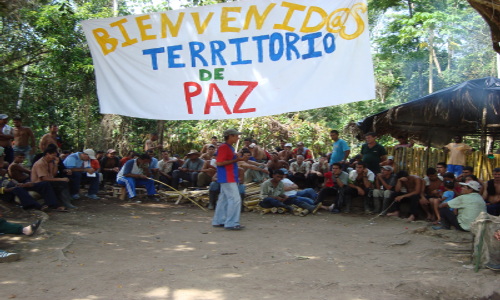
Territory of Peace
Demanding an end to neglect and repression
To get to the camp is a journey. From the nearest town of La Gabarra it is a three-hour drive over a highway that seems more like a dry creek bed than a road. Along the way are abandoned houses and almost empty villages. Much of the population in this area has still not returned after being displaced by the paramilitary violence that devastated the region from 1999 to 2005. Those who have returned have more difficulties than just the atrocious state of the roads. This is an area virtually abandoned by the state. In the majority of communities there are no schools, or if there are schools, they sit deserted, without teachers. In Caño Tomás the nearest hospital is about 6 hours away in Venezuela. The decision to set up the humanitarian refugee camp is a response to this failure to provide social services, as well as the poisonous fumigation campaign to eliminate coca crops that is causing mass displacement in the region.
The majority of farmers in the Catatumbo region grow coca, the plant from which cocaine is derived. The costs of transporting out any and all goods on the long, poorly maintained roads make coca the only economically viable crop for small farmers to grow. In April the government began extensive fumigations and manual eradications of the coca crops, but has not yet proposed a crop substitution plan. They have also failed to take into account the fact that the poisonous chemicals used to fumigate do not only eliminate the coca plant, but contaminate indiscriminately, poisoning rivers and streams and eliminating foods crops which the residents of the region need to survive. These are the main reasons why ASCAMCAT decided to establish the humanitarian refugee camp, but they are not the only ones.
As ASCAMCAT’s official press release explains, “we have demonstrated our willingness to dialogue and coordinate with the government for a real proposal for crop substitution, for the respect of human rights, and for dignified living conditions in the countryside. But the only response that we have ever received has been state violence.” The so-called “false positives” or extrajudicial executions, the continuous illegal raids by state security forces, illegal detentions, and legal prosecution of small farmers are just some examples of this state violence in its most recent forms. The participants in the humanitarian refugee camp hope that this act of dissent will not be met with more state violence. To that end, the camp has been accompanied since its conception, by international human rights workers from the International Peace Observatory, which has accompanied ASCAMCAT since its creation in 2005.
Before the birth of ASCAMCAT the communities of the Catatumbo region manifested their dissent taking to the streets of the department’s capital, Cúcuta. Although these protests won some concessions, they were followed by violent paramilitary incursions and did not achieve any lasting changes in government policy. The humanitarian refugee camp is the next form of protest. It is a space declared by the farmers a “territory of peace” where no armed group is allowed to enter, similar to the Colombian “peace village” of San José de Apartadó and the “humanitarian zones” of the afro-colombian community Cacarica. The humanitarian refugee camp is also a way for rural communities to demand a government response without having to travel into the cities, where the supposedly demobilized paramilitary groups have regrouped and are again exercising social and political control. As Pablo Téllez of ASCAMCAT explains, “We are going to propose from here that the government come to the region and see the situation.” That might take a while, but the farmers in the camp are prepared for a long wait.
Building a movement
There are eight communities currently participating: Morro Frio, La India, El Suspiro, Caño Mariela, Caño Azul, Caño Escondido, Cooperativa Sapadhana and Caño Tomás. Each community has divided itself into delegations that it sends to participate in the camp for one or two weeks at a time. The first people to arrive at the chosen site of the camp found little infrastructure. There was only an old house without a roof and bullet holes visible on the walls, abandoned after being set on fire by paramilitaries several years ago. Dense jungle and a shallow creek bed were all they had to build on. This did not discourage them however, and from the moment they arrived they began to work.
They started by clearing the area with their machetes. In the first week they put up three spacious wooden shelters with plastic roofs from which to hang the hammocks where they sleep. In the weeks that followed they built a large kitchen, a meetinghouse, wide washboards in the creek on which to wash clothes, as well as several more sleeping shelters. They also made a roof for the abandoned house and dug holes for latrines.
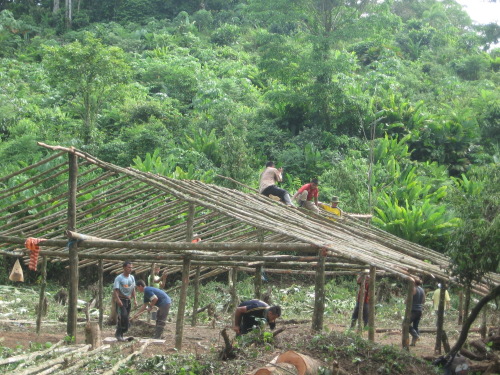
building houses
Conditions are not easy in the camp. The food, provided by the eight communities, is limited, varying between different combinations of rice, yucca, boiled plantains and beef. The land is not irrigated and when the rain falls too hard, the sleeping shelters are flooded. On one occasion heavy rains flooded the river, washing away the washboards. Yet the commitment of the participants has not wavered. When the river washed away the washboards, they simply built others.
Every day they wake up at 5:30 in the morning. The communities take turns with the cooking and each day it is a different group that wakes up earlier than the others to prepare breakfast. While they cook, the rest of the communities clean the area around the camp, collecting and burning garbage and sweeping the shelters. After eating they divide into work groups and continue with projects such as construction of shelters, clearing jungle or painting signs. Around noon, lunch is served and then the afternoon is usually dedicated to study.
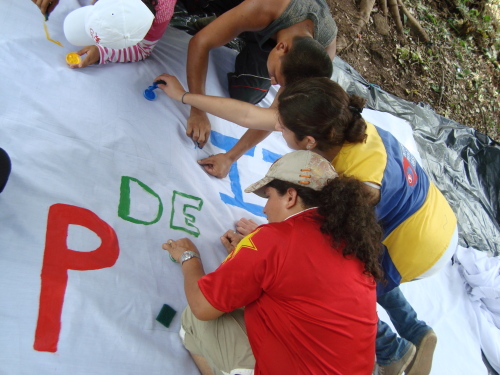
IPO volunteer and farmers paint banners
The same groups that divide up to work in the mornings are given discussion questions by ASCAMCAT to examine in the afternoon. When each group has had a chance to meet, the entire camp gathers to present their conclusions and discuss the themes presented. These themes range anywhere from the reasons behind the camp, the violence of the Colombian state and the effects of fumigations to a discussion of global warming, culture or religion. After this, there is free time, dinner is served, and people go to the creek to bathe and wash their clothes. The communities compete with each other in mini soccer tournaments. In the evening there is culture hour, songs are sung and short plays about families displaced by fumigations or inspired to join the humanitarian refugee camp are presented. By 8:30 everyone is in their hammocks ready to sleep.
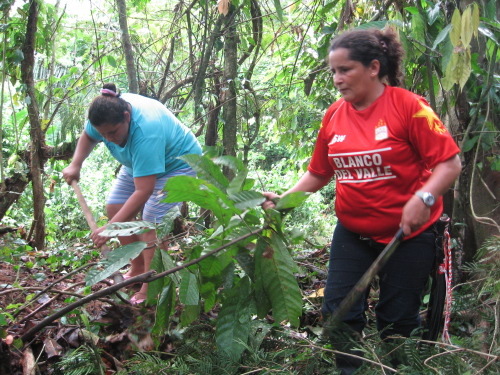
clearing an area in the forest to build a small shelter to change clothes
The days are ordered and productive and a sense of purpose is felt throughout them. The purpose is not just to negotiate with the government but to unite the dispersed communities affected by the actions of the state. In Caño Tomás people from small isolated villages have come to meet people they never would have had the chance to know, people from the same region who have lived similar experiences of violence and neglect. Not only that, but many who never had the chance to receive a formal education, have, for the first time been able to participate in organized discussions about the issues that affect their lives. It is an experience that many will value greatly, even if the government does not ultimately put a stop to the fumigations.
The camp continues to grow and become stronger with each passing day. On May 25th journalists from media throughout the country visited for a press conference held by ASCAMCAT and on June 6th a delegation from the department’s government also paid a visit. Whether or not the national government will take notice remains to be seen, but for the moment the farmers of Catatumbo retain hope.
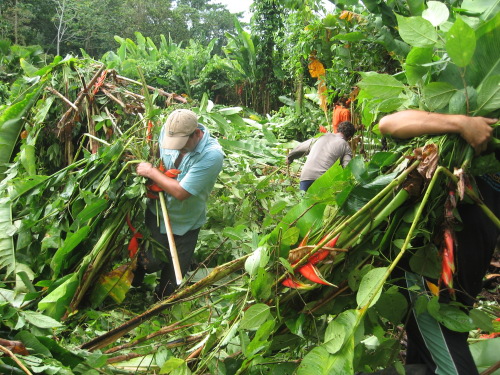
clearing an area to build house